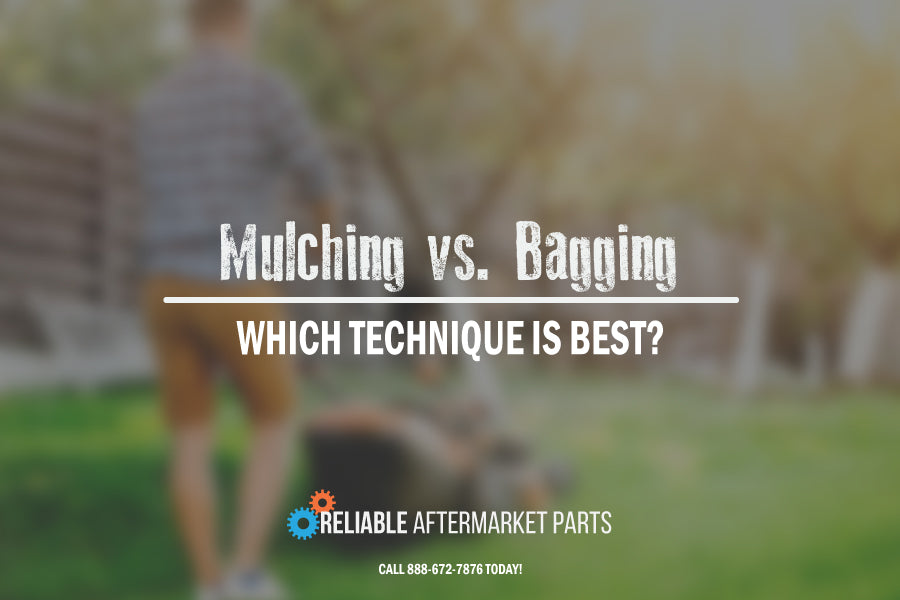It takes more than simply cutting your lawn regularly to maintain a lush, healthy lawn; you also need to select the best cutting strategy for the particular requirements of your yard. The most popular techniques among the many that are available are side discharge, mulching, and bagging. Before choosing which method to use, homeowners should be aware of the needs of their grass as each strategy has benefits and cons. To decide which is ideal for your yard, let's examine the distinctions between bagging, side discharge, and mulching.
MULCHING
The process of mulching entails chopping grass into small pieces and redistributing them around the yard. By using this method, the grass clippings can break down more quickly, giving the soil essential nutrients and functioning as a natural fertilizer. Mulching also helps the soil retain moisture, which lessens the need for frequent watering.
The capacity of mulching to gradually increase soil health is one of its primary advantages. Essential elements like nitrogen, phosphorus, and potassium are released back into the soil by the decomposing clippings, encouraging the growth of healthy grass. Mulch also serves as a barrier, keeping the soil safe from erosion and harsh weather.
Practically speaking, mulching eliminates the need to gather and dispose of grass clippings, saving time and work. In addition, it produces less trash, which makes it a green choice for grass maintenance. However, because mulching can cause clumping and uneven cutting distribution, it might not be the best option for yards with thick or damp grass.
BAGGING
Grass cuttings are bagged and disposed of in other locations, like compost piles or green waste bins, using a mower's associated bag or container. With no discernible clippings remaining on the grass following mowing, this method leaves the lawn looking neat and clean right away.
Because heavy thatch buildup can impede grass growth, bagging is especially helpful for yards with thick or overgrown grass. Additionally, it keeps lawns looking tidy and well-groomed, which makes it perfect for lawns utilized for outdoor events or leisure activities.
Since bagging removes clippings from the lawn completely, it can also help prevent the transmission of disease germs and weed seeds. But compared to mulching or side discharge, bagging takes more time and work because you have to stop sometimes to empty the bag and get rid of the clippings.
SIDE DISCHARGE
As you mow, the side funnel of the mower is used to spew grass clippings into the lawn. This easy-to-use method makes it possible to mow continuously to empty bags or mulching chambers without stopping.
Large yards or places with sparse grass are ideal for side discharge because it allows clippings to be distributed quickly and evenly. Additionally, it keeps clippings from piling up on the lawn's surface, which lowers the possibility of thatch growth and improves air circulation around the grass blades.
Additionally, side discharge is the preferred option for mowing wet or tall grass, as it prevents clumping and clogging of the mower deck. However, side discharge may not be suitable for yards with landscaping features or delicate plants, as it can scatter clippings unpredictably.
CHOOSING THE RIGHT WAY FOR YOU AND YOUR YARD
The ideal lawn mowing method ultimately depends on the unique features and upkeep objectives of your yard. Mulching can be a great option if you value soil health and sustainability because it can help retain moisture and act as natural fertilizer. However, bagging may be a better option if you want to keep your lawn looking immaculate and reduce the spread of weeds, especially in areas with dense or overgrown grass.
Side discharge mowing is a practical and effective technique to cut grass without having to deal with bagging or mulching, especially for people with vast yards or no landscaping. But it's important to think about possible negatives as well, including clippings falling on nearby plants or surfaces.
In conclusion, regular mowing and good lawn care techniques are crucial for keeping a healthy and vibrant grass, regardless of whether you want to mulch, bag, or discharge your lawn from the side. Knowing the benefits and drawbacks of each method will help you make an educated choice that will satisfy the particular requirements of your yard and encourage sustainability over the long run.





